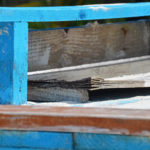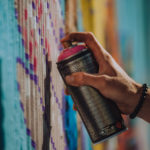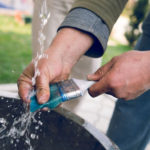For upcycling projects or DIY furniture renovations, chalk paint can help you turn that boring, lifeless piece of furniture into a work of art.
Many who are new to this type of paint often wonder what type of brushes they should buy which is exactly what we will be highlighting in this guide.
You may have seen people using both round and straight brushes in video tutorials, but if you want to make the most of your paint job, you need to make sure you are using the best brush for chalk paint and not some cheap craft store find.
Read on to find out what tools you will need for your next chalk painting project!
Best Brushes for Chalk Paint
| Picture | Name | Width | Price | Rating (1-5) |
|---|---|---|---|---|
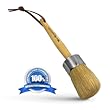 | 1. New Renaissance Professional Chalk Paint Wax Brush | 1.5 inches | $$$ | 4.6 |
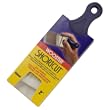 | 2. Wooster Brush Q3211-2 Shortcut Angle Sash Paintbrush, 2-Inch | 2 inches | $ | 4.8 |
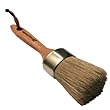 | 3. Brossum 2-in-1 Round Chalk Paint and Wax Brush for Furniture, Natural Bristles | 2 inches | $$$$ | 4.5 |
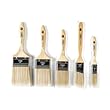 | 4. Presa Premium Paint Brushes Set, 5 Piece | Varies | $$ | 4.6 |
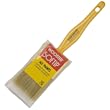 | 5. Wooster Brush Q3108-2 Softip Paintbrush, 2-Inch | 2 inches | $ | 4.6 |
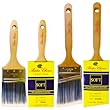 | 6. Bates Choice Paint Brush Set with cover, 2 Piece | Varies | $$$ | 4.4 |
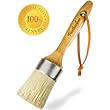 | 7. Featherline Series Professional 2 Inch Diameter Premium Oval Chalk & Wax Boar Bristle Brush | 2 inches | $$$ | 4.1 |
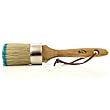 | 8. 1st Place 2-in-1 Chalk Paint & Wax Pure Bristle 2 Inch Hand Made Round Brush | 2 inches | $$$ | 4.4 |
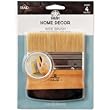 | 9. FolkArt Home Decor Chalk Wide Brush, 34910 | 4 inches | $$ | 4.4 |
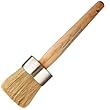 | 10. Chalk Painter's Choice - XL Professional Wax Brush {R20} | 2 inches | $$$ | 4.3 |
Round or Straight?
Typically, the best paint brush for chalk paint projects is a round one. You will use these brushes to apply both paint and the wax finish that goes on top of the paint to seal and protect it.
Straight brushes can be equally as handy, although you can only use them to apply the paint and not the wax.
For getting into tight corners, an angled brush is quite handy, while flat brushes are great for covering smooth surfaces and long strokes.
Check out the Bristles
There are two types of bristles – synthetic and natural.
Natural bristles come from real animals such as boar, goat, pony, squirrel or sable.
Synthetic bristles are made from polyester or nylon (sometimes a combination of both).
Since both work well with chalk paint, it is a matter of preference when you are comparing and contrasting them. If you’re looking for a cruelty-free product, then obviously synthetic is the way to go.
Be sure to avoid brushes with stiff bristle tips, as they will leave harsh, unsightly streaks on the surface as you paint.
Width of the Brush Head
Another thing you should look at as you shop for a brush is the width of the brush head.
For larger projects, you will cover more ground with a wide, straight brush than you will with a round brush, although getting into tight areas will be difficult.
Most of the round brushes have a 2-inch diameter, which is sufficient for many projects. The New Renaissance Chalk Paint & Wax Brush, however, is only an inch and half, and that half an inch does make a difference in your painting time!
Top 3 Best Brush for Chalk Paint Reviews
1. New Renaissance Professional Chalk Paint Wax Brush

Specifications:
- Material: Wood, Bristles, Metal, Leather
- Bristle Type: Natural
- Dimensions: 9 x 2 x 3 inches
- Weight: 3.2 ounces
We were very pleased with the results of New Renaissance’s Chalk and Wax Brush.
If you are using quality chalk paint, then you will achieve just the right effect when using a brush like this. Shedding is minimal, and the natural bristles give you an equally natural look on the surface of your project.
We would advise against using the same brush to paint and then wax, even if you do clean it thoroughly between uses.
Since this brush can be used with both substances, just buy two so you can designate one for paint and the other for wax.
While you may prefer to spring for a less expensive brush because you are on a budget, it’s worth it, in the long run, to invest in something serious like this, especially if you paint on a regular basis.
2. Wooster Q3211-2 Shortcut Angle Sash Paintbrush

Specifications:
- Material: Other
- Bristle Type: Synthetic (nylon and polyester)
- Dimensions: 1 x 8 x 3 inches
- Weight: 1.6 ounces
For precise application, we found Wooster Brush’s Angle Sash Paintbrush to be a very useful tool.
It may be designed to use on walls and trim, but if you are painting cabinet doors, cupboards, desks, or a chest of drawers, a brush like this works like a dream on all straight, flat surfaces.
One thing we didn’t like was the short handle, which is only 2¼ inches long. It was more like a little nub than a handle, but once we got the hang of it, we didn’t have any issues.
The tips of the bristles are slightly feathered, so you won’t have any of those harsh streaks that stiff tips leave behind.
We recommend using natural products to wash the brush and avoid any of the harsh, chemical-based cleaners. Some dish soap and hot water should get that chalk paint off there in a jiffy!
3. Brossum 2-in-1 Round Chalk Paint and Wax Brush
Specifications:
- Material: Wood
- Bristle Type: Natural
- Dimensions: 9 x 3 x 2 inches
- Weight: 2.39 ounces
This brush is similar to the New Renaissance Brush we tried – both have natural bristles and work great with chalk paint, but even though this one is slightly more expensive, more people purchase it because it is wider.
Shedding is a problem with the lower-quality brushes, which can be a hassle when you are constantly picking out bristles from your wet paint and then passing over the spot again to cover the hole.
Thankfully, this brush doesn’t have that problem, and it is safe to use with both chalk paint and wax.
If the New Renaissance Brush was too narrow, opt for this one.
Frequently Asked Questions
Why Does my Chalk Paint Look Streaky?
If your chalk paint looks streaky, it’s most likely because the paint is too dry. When this happens, the paint can pull away from the surface, causing an uneven or streaky finish. The best way to avoid this problem is to keep your paint well-hydrated.
This means adding water to the mixture and stirring it well before painting. You should also avoid painting in direct sunlight or very humid conditions. If you experience streaking, you can use a higher quality paint or a different chalk paint altogether.
With a little trial and error, you should be able to find a paint that gives you the smooth, even finish you’re looking for.
Do I Need a Special Brush for Chalk Paint?
No, you don’t need a special brush for chalk paint, but we recommend using one anyway. A good quality brush will lay down the paint evenly and prevent any streaking or bristles from being left behind.
Is Chalk Paint Easy to Use?
Chalk paint is easy to use, but you should still take your time and apply it evenly. Be sure to let each coat dry completely before applying the next one.
You may also want to use a brush specifically designed for chalk paint to get an even finish and avoid streaks or bristles being left behind.
Conclusion
All of the brushes we tried were great for applying chalk paint, but if we had to choose just one, it would be the Brossum 2-in-1 Round Chalk Paint and Wax Brush. It has no bristle problems like shedding, and it works with chalk paint and wax.
Plus, at a reasonable price point, this brush is an affordable option that will last you a long time.


